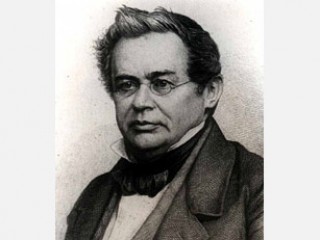
Heinrich Friedrich Emil Lenz biography
Date of birth : 1804-02-12
Date of death : 1865-02-10
Birthplace : Dorpat, Estonia
Nationality : Russian-German-Estonian
Category : Science and Technology
Last modified : 2010-05-26
Credited as : Physcist, Lenz's law in electrodynamics in 1833,
3 votes so far
Heinrich Friedrich Emil Lenz was Russian physicist who in 1833 formulated Lenz’s law, a fundamental law of electromagnetism. He also found that the strength of a magnetic field is proportional to the strength of the magnetic induction. Heinrich Friedrich Emil Lenz was born and educated in Dorpat (now Tartu, Estonia).
As geophysical scientist, he accompanied Otto von Kotzebue (1787-1846) on his third expedition around the world 1823-26. On his voyage with Kotzebue, Lenz studied climatic conditions such as barometric pressure, and made extremely accurate measurements of the salinity, temperature, and specific gravity of sea water. On a later expedition he measured the level of the Caspian Sea. On his return, Lenz joined the St Petersburg Academy of Science, and from 1840 held posts at the University of St. Petersburg.
Lenz’s studies of electromagnetism date from 1831. He is best-known for Lenz’s law, which he discovered in 1834 while investigating magnetic induction. The Lenz’s law in electromagnetism is a statement that an induced electric current flows in a direction such that the current opposes the change that induced it.
Thrusting a pole of a permanent bar magnet through a coil of wire, for example, induces an electric current in the coil; the current in turn sets up a magnetic field around the coil, making it a magnet. Lenz’s law indicates the direction of the induced current.
Because like magnetic poles repel each other, Lenz’s law states that when the north pole of the bar magnet is approaching the coil, the induced current flows in such a way as to make the side of the coil nearest the pole of the bar magnet itself a north pole to oppose the approaching bar magnet. Upon withdrawing the bar magnet from the coil, the induced current reverses itself, and the near side of the coil becomes a south pole to produce an attracting force on the receding bar magnet.
A small amount of work, therefore, is done in pushing the magnet into the coil and in pulling it out against the magnetic effect of the induced current. The small amount of energy represented by this work manifests itself as a slight heating effect, the result of the induced current encountering resistance in the material of the coil. Lenz’s law upholds the general principle of the conservation of energy. If the current were induced in the opposite direction, its action would spontaneously draw the bar magnet into the coil in addition to the heating effect, which would violate conservation of energy.
In 1833 Lenz reported investigations into the way electrical resistance changes with temperature, showing that an increase in temperature increases the resistance (for a metal). Lenz also studied the relationship between heat and current and discovered, independently of English physicist James Joule, the law now known as Joule’s law, which shows that heating effects accompany the flow of electricity in conductors.
In August, 1864, Lenz went to Italy for medical reasons (he had chronic problems with eyes), but he died on February 10, 1865, in Rome after suffering a stroke.
















